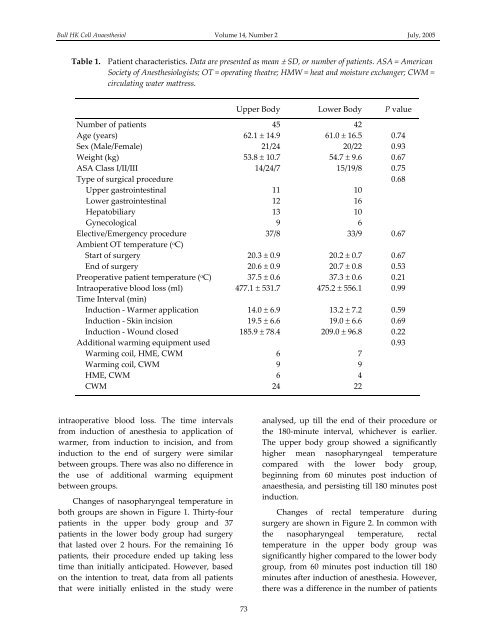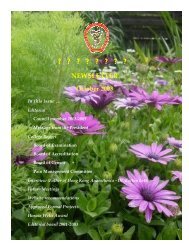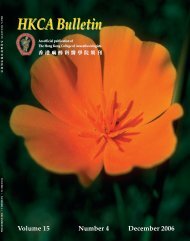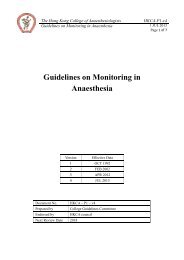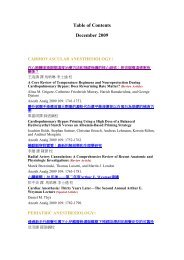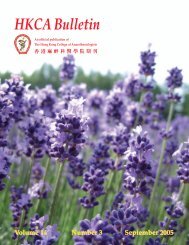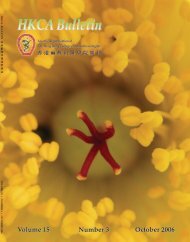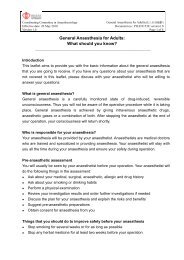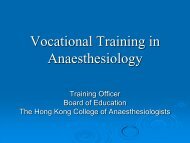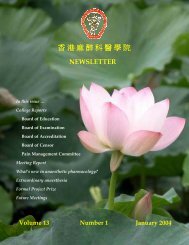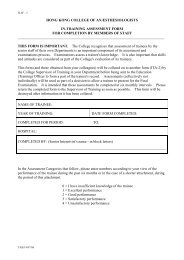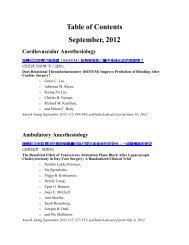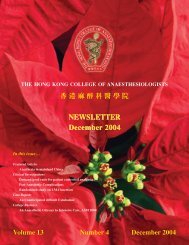July 2005 - The Hong Kong College of Anaesthesiologists
July 2005 - The Hong Kong College of Anaesthesiologists
July 2005 - The Hong Kong College of Anaesthesiologists
You also want an ePaper? Increase the reach of your titles
YUMPU automatically turns print PDFs into web optimized ePapers that Google loves.
Bull HK Coll Anaesthesiol Volume 14, Number 2 <strong>July</strong>, <strong>2005</strong>Table 1. Patient characteristics. Data are presented as mean ± SD, or number <strong>of</strong> patients. ASA = AmericanSociety <strong>of</strong> Anesthesiologists; OT = operating theatre; HMW = heat and moisture exchanger; CWM =circulating water mattress.Upper Body Lower Body P valueNumber <strong>of</strong> patients 45 42Age (years) 62.1 ± 14.9 61.0 ± 16.5 0.74Sex (Male/Female) 21/24 20/22 0.93Weight (kg) 53.8 ± 10.7 54.7 ± 9.6 0.67ASA Class I/II/III 14/24/7 15/19/8 0.75Type <strong>of</strong> surgical procedure 0.68Upper gastrointestinal 11 10Lower gastrointestinal 12 16Hepatobiliary 13 10Gynecological 9 6Elective/Emergency procedure 37/8 33/9 0.67Ambient OT temperature ( o C)Start <strong>of</strong> surgery 20.3 ± 0.9 20.2 ± 0.7 0.67End <strong>of</strong> surgery 20.6 ± 0.9 20.7 ± 0.8 0.53Preoperative patient temperature ( o C) 37.5 ± 0.6 37.3 ± 0.6 0.21Intraoperative blood loss (ml) 477.1 ± 531.7 475.2 ± 556.1 0.99Time Interval (min)Induction ‐ Warmer application 14.0 ± 6.9 13.2 ± 7.2 0.59Induction ‐ Skin incision 19.5 ± 6.6 19.0 ± 6.6 0.69Induction ‐ Wound closed 185.9 ± 78.4 209.0 ± 96.8 0.22Additional warming equipment used 0.93Warming coil, HME, CWM 6 7Warming coil, CWM 9 9HME, CWM 6 4CWM 24 22intraoperative blood loss. <strong>The</strong> time intervalsfrom induction <strong>of</strong> anesthesia to application <strong>of</strong>warmer, from induction to incision, and frominduction to the end <strong>of</strong> surgery were similarbetween groups. <strong>The</strong>re was also no difference inthe use <strong>of</strong> additional warming equipmentbetween groups.Changes <strong>of</strong> nasopharyngeal temperature inboth groups are shown in Figure 1. Thirty‐fourpatients in the upper body group and 37patients in the lower body group had surgerythat lasted over 2 hours. For the remaining 16patients, their procedure ended up taking lesstime than initially anticipated. However, basedon the intention to treat, data from all patientsthat were initially enlisted in the study wereanalysed, up till the end <strong>of</strong> their procedure orthe 180‐minute interval, whichever is earlier.<strong>The</strong> upper body group showed a significantlyhigher mean nasopharyngeal temperaturecompared with the lower body group,beginning from 60 minutes post induction <strong>of</strong>anaesthesia, and persisting till 180 minutes postinduction.Changes <strong>of</strong> rectal temperature duringsurgery are shown in Figure 2. In common withthe nasopharyngeal temperature, rectaltemperature in the upper body group wassignificantly higher compared to the lower bodygroup, from 60 minutes post induction till 180minutes after induction <strong>of</strong> anesthesia. However,there was a difference in the number <strong>of</strong> patients73


